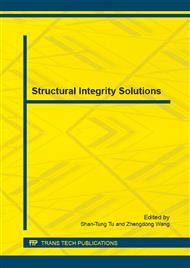[1]
Z. Barsoum, Residual stress analysis and fatigue of multi-pass welded tubular structures, Engineering Failure Analysis 15 (2008) 863-874.
DOI: 10.1016/j.engfailanal.2007.11.016
Google Scholar
[2]
W.C. Jiang, Z.B. Liu, J.M. Gong, S.T. Tu, Numerical simulation to study the effect of repair width on residual stresses of a stainless steel clad plate, International Journal of Pressure Vessels and Piping 87 (2010) 457-463.
DOI: 10.1016/j.ijpvp.2010.06.003
Google Scholar
[3]
W.C. Jiang, X.P. Xu, J.M. Gong, S.T. Tu, Influence of repair length on residual stress in the repair weld of a clad plate, Nuclear Engineering and Design 246 (2012) 211-219.
DOI: 10.1016/j.nucengdes.2012.01.021
Google Scholar
[4]
W.C. Jiang, B.Y. Wang, J.M. Gong, S.T. Tu, Finite element analysis of the effect of welding heat input and layer number on residual stress in repair welds for a stainless steel clad plate, Materials and Design 32 (2011) 2851-2857.
DOI: 10.1016/j.matdes.2010.12.037
Google Scholar
[5]
P.J. Bouchard, D. George, J.R. Santisteban, G. Bruno, M. Dutta, L. Edwards, E. Kingston, D.J. Smith, Measurement of the residual stresses in a stainless steel pipe girth weld containing long and short repairs, International Journal of Pressure Vessels and Piping 82 (2005).
DOI: 10.1016/j.ijpvp.2004.08.008
Google Scholar
[6]
D. George, D.J. Smith, Through thickness measurement of residual stresses in a stainless steel cylinder containing shallow and deep weld repairs, International Journal of Pressure Vessels and Piping 82 (2005) 279-287.
DOI: 10.1016/j.ijpvp.2004.08.006
Google Scholar
[7]
T.L. Teng, C.C. Lin, Effect of welding conditions on residual stresses due to butt welds, International Journal of Pressure Vessels and Piping 75 (1998) 857-864.
DOI: 10.1016/s0308-0161(98)00084-2
Google Scholar
[8]
H.M. Lu, Y.Y. Chen, Handbook of Mechanical Engineering Material Performance, Mechanical Industry Press, Beijing, (1995).
Google Scholar
[9]
J.Z. Pan, Practical Material Handbook of Pressure Vessels for Carbon and Low-alloy Steel, Chemical Industry Press, Beijing, (2000).
Google Scholar
[10]
T.L. Teng, C.P. Fung, P.H. Chang, W.C. Yang, Analysis of residual stresses and distortions in T-joint fillet welds. International Journal of Pressure Vessels and Piping, 78 (2001) 523-538.
DOI: 10.1016/s0308-0161(01)00074-6
Google Scholar
[11]
Goldak K, Chakaravarti A, Bibby M. A new finite element model for welding heat sources. Metallurgical Transactions B, 15(1984) 299-305.
DOI: 10.1007/bf02667333
Google Scholar
[12]
D. Deng, H. Murakawa, W. Liang, Numerical and experimental investigations on welding residual stress in multi-pass butt-welded austenitic stainless steel pipe, Computational Materials Science 42 (2008) 234-244.
DOI: 10.1016/j.commatsci.2007.07.009
Google Scholar


